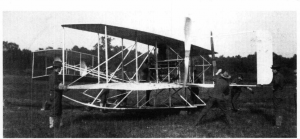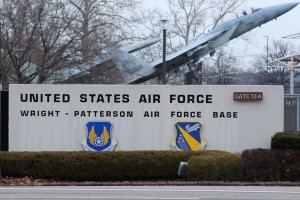In 1909, the United States Army Signal Corps contracted with the Wright Company, and purchased its first airplane. In a makeshift airfield just outside of Dayton, Ohio, the newly Army-owned Wright Military Flyer was sent on a successful test flight. This purchase sparked the beginning of what would later become the United States Air Force, and the location to become the Wright Patterson Air Force Base.
Before the Great War
The land Wright Patterson Air Force Base currently rests on may just have well been the birthplace of military aviation. Though zeppelins had been around for some time, the mobile airplane was just hitting the scene as the Wright brothers were making new advances every year. On the northwest side of Dayton, Ohio, Wright Patterson Air Force Base lies on lands previously owned by the forefathers of flight—Wilbur and Orville Wright. This land was temporarily known to the Army as Wilbur Wright Field.

Before the United States Military had the official United States Air Force, it had a couple of predecessors. The first of which was the Aeronautical Division of the Army Signal Corps. Though much of its initial duties involved studying weather patterns and communication, upon purchasing its first Wright Military Flyer, the Signal Corps’ received a new mission—determine how this airplane could be used in combat [6]. The last constraint of the Signal Corp’s contract with the Wright brothers after purchasing the first military airplane was that officers needed to be trained to fly this new plane. Since they were the ones who created the product, the Wright Brothers were giving the task of training the test pilots. When the Signal Corps realized the effectiveness of having usable and relatively mobile aircraft, a permanent pilot and mechanic training program was created at Wilbur Wright Field, as one of the first in the country. Further development of military aircraft continued at Wright Field, including the synchronized-through–the–propeller machine gun, which allowed for the airplanes armament to be directly in line with the pilot. [3]
Post World War 1
After World War One, several hundred captured German aircraft were stored in hangars at Wilbur Wright Field for analysis and preservation. Many of the German artifacts were placed in the Army Aeronautical Museum, which is now known as the National Museum of the United States Air Force, located at Wright Patterson Air Force Base. Also, since no one thought another war the size of World War 1 was imminent, the flight school at Wilbur Wright Field was discontinued. However, President Woodrow Wilson realized that the necessity of an air power was too large to not have its own branch within the Army, so the United States Army Air Service was commissioned. Years later, the name was changed to the Army Air Corps. When Europe started getting more hostile in the 1930s, Wilbur Wright Field was brought back into use for training and further testing. Training exercises such as mock air attacks on Fort Knox were based out of Wright Field, given its relatively close proximity, and the fact that airplanes could then fly that distance.
As United States military has dictated, when World War Two broke out, the military ramped up its size and power again. Named after Lieutenant Patterson who was killed in a plane crash testing the new synchronized through the propeller machine gun, Patterson Field was added to Wilbur Wright Field. Also, the Army built over 30 new buildings and hangars and produced the Air Corps’ first paved runways in the world. The airfields grew greatly in size in order to train and house troops. The Air Corps began training its first officers in crash intelligence—or studying enemy aircraft and equipment. This would become especially crucial after the war, and aid in American advances in airpower. By the end of the war, the hangars at Wright and Patterson fields were filled with German and Japanese aircraft, including one of the first jet engines.
After the conclusion of World War Two, not only was it determined that the United States should maintain its war powers even in peacetime, but also that an air force was too large and needed to become its own branch. So, in 1947, the United States Air Force was created. Soon to follow, the Wright and Patterson Fields were turned into the permanent Wright Patterson Air Force Base (WPAFB), a name that has continued to this day. In having its own branch and base, the Air Force could receive its own congressional funding and perform its own training and research without the limitations of the Army. The Air Force now has its own bases in countries all across the world.
Also after World War Two, Wright Patterson Air Force Base was utilized heavily in Operation Paperclip. This lesser known and somewhat unpopular operation by the United States government brought German and Nazi scientists and engineers from World War Two over into the United States. These scientists were in a way forced to give up their findings and conduct further research in order to avoid imprisonment. Engineers with their rocket and missile technology, such as the V-2 Rocket and jet powered aircraft were brought into WPAFB to be studied, altered and then implemented back into America’s own military. It is agreed that had the United States not used these scientists and engineers as resources for knowledge, programs such as NASA or jet powered aircraft would either not exist or at least not be nearly as successful as they are today.[8]
Modernity
In 1989 a crowd anxiously waited the unveiling of what had been kept secret for many years. The crowd was sitting in bleachers at the Dayton Air Show at Wright Patterson Air Force Base. Then shade cast itself across the bleachers as the dark floating mass of the B-2 Stealth Bomber soared overhead. At the finale of the Cold War, this first unveiling of the new top-secret aircraft shocked the nation, and especially those lucky few at the airshow. This world-famous airshow continues to this day, but is now known as the Vectren Dayton Airshow, and is still held annually at Wright Patterson Air Force Base. People from across the Midwest come to Dayton, Ohio to see aircraft—new and old. Flight teams such as the Navy’s Blue Angels and the Air Force’s Thunderbirds dazzle audiences with acrobatic air maneuvers. This event is one of several large-scale recruiting events across the nation/. Though throughout its tenure there have been several fatal crashes in front of thousands of fans, the air show brings in large crowds, boosting the local economy, and increasing the size of the armed forces. [2]

Wright Patterson Air Force Base continues also as a pilot and mechanic training center, research center, and museum, employing over 26,000 airmen and civilians [4]. This makes it the largest single-site employer in the state of Ohio. Notable research at the base includes studies during Project Sign, Project Grudge, and Project Blue Book. These projects were the Air Force’s first investigations of unidentified flying objects (UFOs). When only skeptical evidence from the top secret projects was revealed to the public and the government, the projects were discontinued, but classified evidence was left in storage. The museum at Wright Patterson Air Force Base contains aircraft starting all the way back to the Wright Military Flyer. It also includes many real and reproduced spacecraft utilized throughout American history. [9]
Wright Patterson Air Force Base, and its predecessors, has been on the main scene of the advancement of United States air power from its very start in 1909, and continues its research and training to this day. With rumors of a new branch known as the Space Corps, Wright Patterson Air Force Base remains on the cutting edge of the progression of air and space technology. [10]
Primary Sources
- Thunderbirds perform at 2011 Dayton Air Show. (2011, Jul 27). US Fed News Service, Including US State News
- By Eileen, W. R. (1988, Apr 21). Super-secret no more, stealth bomber unveiled by U.S., but cost still evasive. Wall Street Journal Retrieved from
Secondary Sources
- Gilbert, B. (2003, Dec 22). The wright brothers’ role in military aviation. Human Events, 59, 24.
- Wright Patterson Air Force Base (2017), Employer Fact Sheet
- Fox News (2013), “Plane with Wing Walker Crashes at Ohio Air Show”
- Warnock, A. T. (2002). From infant technology to obsolescence: The wright brothers’ airplane in the U.S. army signal corps, 1905-1915. Air Power History, 49(4), 46-57.
- Cook, K. L. (2004). “The army buys an airplane.” MHQ: The Quarterly Journal of Military History
- Huddleston, R. (2015). “Operation paperclip: The secret intelligence program that brought nazi scientists to America/The nazis next door: How america became a safe haven for Hitler’s men.” Air Power History
- Wright Patterson Air Force Base (2017). “Fact Sheet”
- Fabey, M. (2017). “Debate intensifies over Rogers’ Space Corps proposal”
For further reading
https://en.wikipedia.org/wiki/United_States_Army_Air_Corps#Lineage_of_the_United_States_Air_Force
